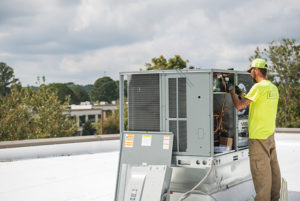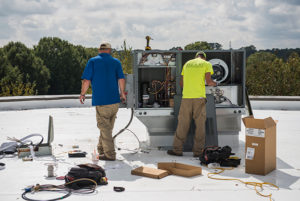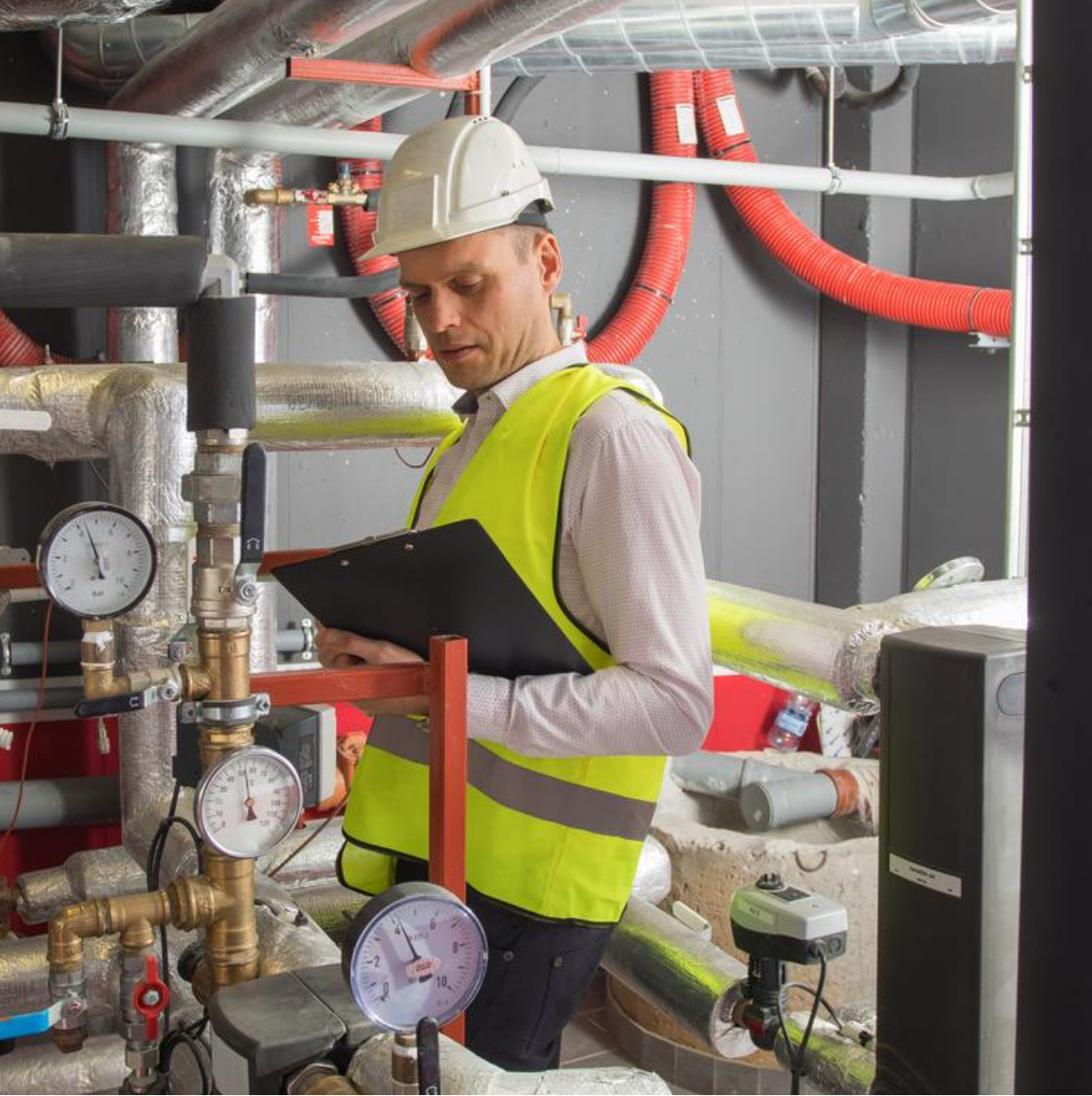From time-to-time, we receive questions from customers relating to the maintenance of their heating and cooling systems. We’re always happy to respond to these questions, and believe that other customers may benefit from the answers as well. Below are our answers to six of the most frequently asked questions we receive:
Q: How often should I change my furnace and air conditioner filters?
A: Exactly how often your HVAC filters should be changed varies, depending on a number of factors such as:
- The type of filter your HVAC system uses (pleated cloth filters typically last longer than fiberglass filters).
- The overall air quality inside your building.
- The overall air quality in your community.
- The number of people (employees, visitors, etc.) normally in the facility.
- The level of soot, dust, smoke or other airborne contaminants inside the building.
- The proximity of your facility to traffic; the closer to a street and the heavier the traffic, the more often the filters will need to be replaced.
In general, filters in high-traffic areas such as laundromats, hotels, schools and retail stores should changed every 90 days, on average. If your building is in a low-traffic area, or if your community has low smog levels, you may be able to go a little longer before having to replace your filters. On the other hand, if your building is in a high pollen or high dust environment, your filters may need to be changed much more frequently than just every 90 days.
The best way to know if your filters should be replaced is to take them out and inspect them on both sides. If the filter has turned gray in color, has a layer of dirt covering most of the surface, or if the surface has tears or holes, these are signs that the filter needs to be replaced.
 Q: How long should my refrigerant last?
Q: How long should my refrigerant last?
A: The refrigerant charge should last the entire lifetime of your equipment—as long as none of the components are broken or in need of repair. Keep in mind that the refrigerant used in your cooling system is considered a “self contained” or “closed” system.” If everything is functioning as it should be, no refrigerant should escape or seep out of your equipment.
Some people think AC refrigerant gets “used up” in the same way an automobile uses gasoline, but this is not true. The refrigerant’s job is to absorb heat from your building’s indoor air and transfer it outdoors, lowering your indoor air temperature. During this process, the refrigerant changes from a liquid to a gas, and then back a liquid. The quantity of refrigerant is not reduced during this process.
The only time refrigerant might need to be added is during one of the following scenarios:
- There is a leak, and refrigerant has leaked out of the system. (This is a repair that must be addressed, because otherwise the leaking will be a reoccurring issue).
- The air conditioning equipment was installed incorrectly.
- Someone is stealing the refrigerant to get high off it (this is known as “refrigerant huffing” or “Freon huffing”).
A telltale sign that you have a leak is if your AC system no longer blows as cool as it once did. Of course the only way to know for sure if your system has a leak is to have it inspected by an HVAC professional. If there is a leak, your equipment will need to be repaired and the refrigerant will need to be refilled to the proper level.
Q: When will the R-22 refrigerant be phased out?
A: R-22, commonly known as Freon, is one of the most commonly used refrigerants used in residential and commercial air conditioning systems. R-22 will be completely phased out, per regulations by the Environmental Protection Agency (EPA), by January 1, 2020. After this date, there will be a total ban on the production and importation of R-22 in the United States.
The reason for this phase-out is that R-22 is a greenhouse gas, believed to contribute to the depletion of the earth’s ozone layer (which is what absorbs harmful UV radiation) and global warming.
In 1987, 190 countries—including the United States—came together to sign the Montreal Protocol, an international treaty governing the protection of the ozone from depletion. A schedule was established for a gradual phase-out of R-22 (along with other ozone-depleting chlorofluorocarbons). Strict guidelines were set, stipulating how much R-22 was allowed to be produced during each year leading up to the total ban.
As of 2017, the production and importation of R-22 in the U.S. was reduced to 13 million pounds. In 2018 the limit will be 9 million pounds, and in 2019, just 4 million pounds. With each passing year leading up to 2020, R-22 is becoming more scarce, driving up prices for it.
Starting in 2010, AC systems designed and manufactured in the U.S. were required to use an alternative, non-ozone-depleting substitute refrigerant. This means that if your facility’s cooling system was manufactured after 2010, the R-22 phase-out probably won’t affect you. However, if your system was manufactured before 2010 and it has a leak in the years ahead, you may need to invest in a new cooling system which uses an EPA-approved refrigerant, or have your existing system converted (or “retrofitted”) to use an alternative refrigerant. You may simply not be able to obtain replacement R-22, either because the supply is gone or the price is too high.
Q: What is the recommended set points in heating and cooling to save energy? 
A: To lower power and utility bills, Georgia Power recommends homeowners and businesses set their thermostats to 68 degrees Fahrenheit during the winter months and 78 degrees in the warmer summer months. According to Georgia Power, with each degree decrease on the thermostat in the winter or increase in the summer, energy usage (and ultimately utility bills) will be reduced by 3 percent to 4 percent.
If there are long periods within each 24-hour period when your facility is empty (such as at night), adjusting the indoor temperature a few degrees more (either up or down, depending on the time of the year) with save you even more.
Some people worry that their HVAC systems will have to “work harder” than normal (eliminating any monetary savings) after their thermostats have been turned up or set back, to return their facilities to a comfortable temperature. This is a common misconception. The exact opposite is actually the case. During hot weather, when a building’s interior temperature goes above its usual setting, the rate that heat enters the building actually slows down. In the winter, the cooler interior temperature slows the rate that heat is lost to the surrounding environment.
The U.S. Department of Energy reports that lowering the thermostat lower by 7 to 10 degrees Fahrenheit from its normal setting for eight hours a day can save as much as 10 percent a year on heating and cooling. This can translate into a considerable amount of money for a business with a large facility and high energy usage.
Q: How long should I expect my heating and air conditioning equipment to last?
A: In general, if your equipment is properly maintained, a gas furnace should last around 20 years, and a package or split air conditioning system should last around 15 years. Proper maintenance for your HVAC system means having an annual tune-up or maintenance check, replacing the filters when needed, and making sure the condensing unit (outdoors) is free of dirt build-up and other debris.
Another factor that can impact the life expectancy of your cooling system is where you live. Here in Georgia, your air conditioning unit will likely run 24-hours a day, five or six months straight, from late spring to early fall. In contrast, the same system in Minnesota might only be “working hard” for only one or two months a year. The continual wear and tear on the AC unit, even when it is well maintained, might cause it to fail sooner than one used for a much shorter season each year.
The brand you buy can also come into play. There’s the old saying, “You get what you pay for.” This is true when it comes to your heating and air conditioning equipment, just as it is with so many other types of purchases. When you buy a quality product from a trusted manufacturer, and have it installed and maintained by a top-notch, professional team of HVAC professionals, there’s a much better chance that your equipment will last a long time.
Q: How would I benefit from a planned maintenance agreement?
A: We believe there are many reasons to sign up for a planned preventative maintenance agreement. Some of the top benefits are:
- It keeps your facility’s heating and cooling system running at peak efficiency, saving you money on energy bills. Industry experts report that routine HVAC maintenance can lower a facility’s utility bills by anywhere from 10 to 40 percent.
- Potential problems are identified early, while they are relatively simple to remedy, which will prevent more expensive and complex repairs down the road.
- It can prolong the life of your equipment, often past the extended mark. In general, poorly-maintained systems function only about three-fourths of their suggested life spans due to early system failure.
- Indoor air quality is improved. Dirty coils and blower parts within an air conditioning unit can lead to poor air quality. Keeping HVAC components clean reduces or eliminates airborne contaminants, keeping the air clean. This, in turn, promotes good employee health, and may even reduce absenteeism.
- Customers who have signed up with our planned maintenance agreement receive priority treatment on service calls, guaranteeing that they will receive prompt, punctual service.
- Planned maintenance customers also receive lower service labor service rates; having essential maintenance performed on an unplanned basis always costs more.
When you have a preventative maintenance program, there’s no chance of you forgetting to have the maintenance done because we’ve already got it on our calendars. We’ll come out to your facility in the spring, in the summer, in the fall, and again in winter. During each visit, your complete heating, cooling and electrical system will be inspected.
If you are interested in a planned maintenance agreement with Legacy Mechanical, give us a call today and we’ll customize your maintenance check to meet your exact needs.

CONTACT USLet’s chat.
For a no-cost, no-obligation estimate, give us a call at 770-432-1171 or fill out the form below.
Services
Committed to Serving You
-
Extensive, Relevant Experience You Can Trust.Our Principals have a combined 80+ years of experience in the HVAC industry and 50+ years of craft supervision experience.
-
We Design and Build Custom Solutions.Our engineering staff can design/build a system to suit any customers’ needs. We also have Central HVAC Plant experts on staff that can help with the design, construction, and upgrade of large HVAC operations.
-
From Minor Retrofits to Major Industrial Construction.We have the experience to handle any project from the smallest tenant retrofit to large new construction projects, medical facilities (including surgery and trauma centers), industrial and institutional projects.


